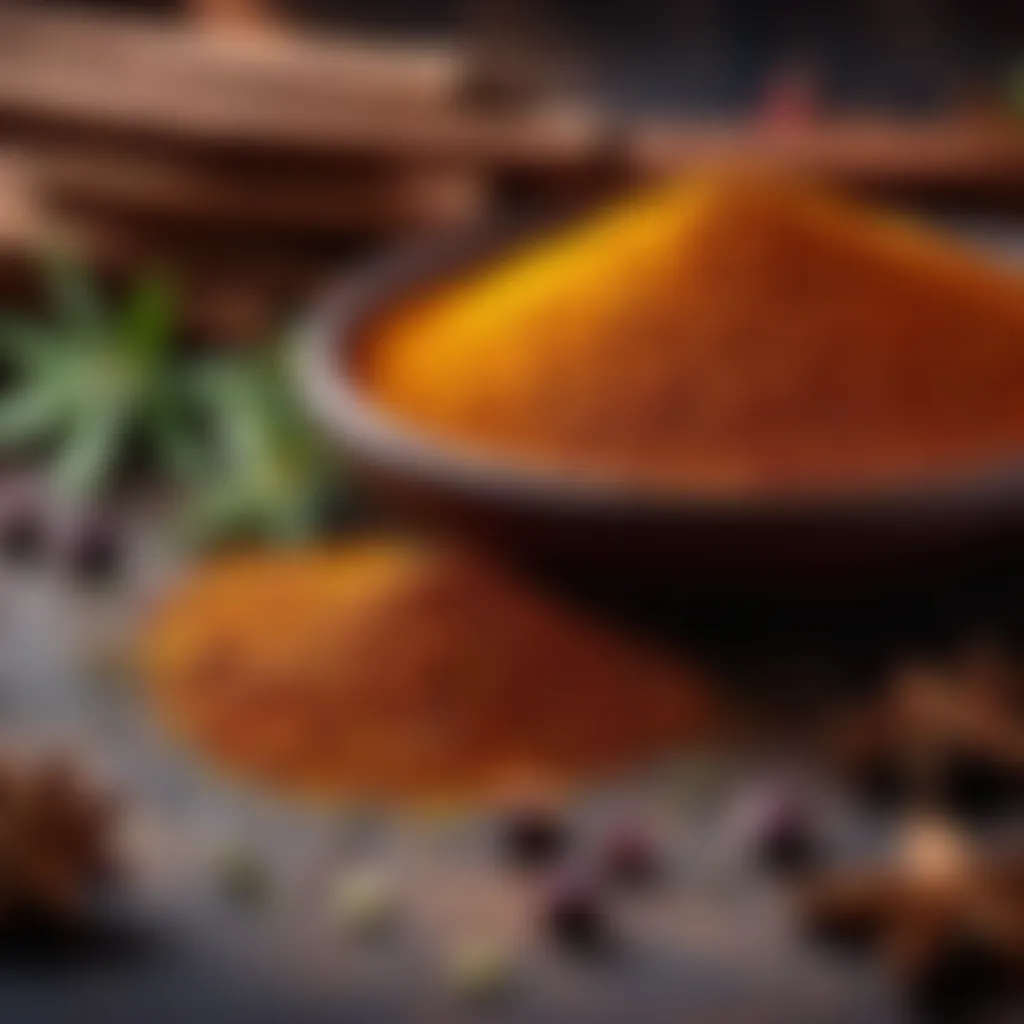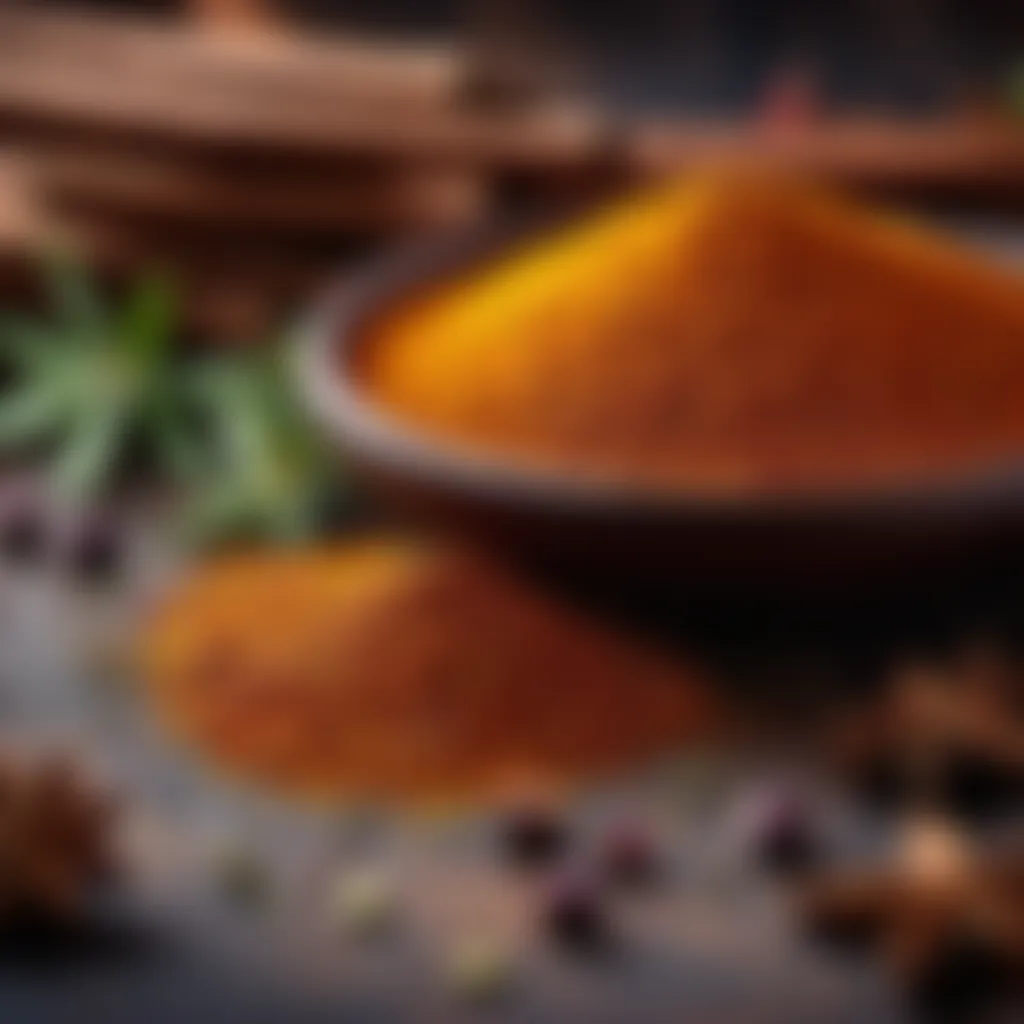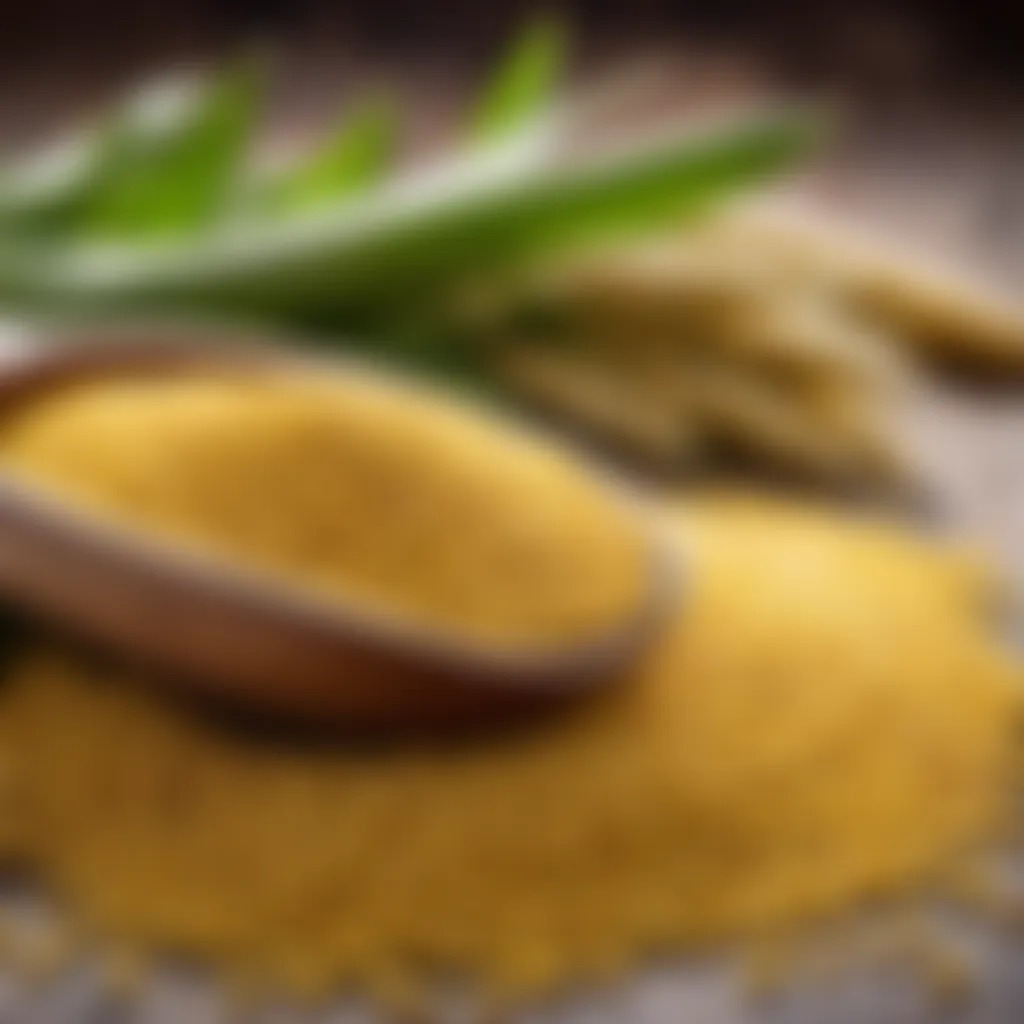Discovering the Rich Flavors of Djerma Cuisine


Intro
Djerma cuisine is a captivating blend of history, tradition, and flavors that speaks volumes about the rich culture of the Djerma people. Often overlooked in the whirlwind of global gastronomy, this culinary landscape offers a treasure trove for those keen on exploring unique tastes and age-old cooking techniques. Every meal tells a story, echoing the community's heritage, from the way ingredients are sourced to the meticulous preparation methods passed down through generations.
Whether you’re already familiar with Djerma cuisine or it’s entirely new territory for you, this guide will lead you on a journey through one of its traditional recipes that captures its essence beautifully. You’ll find everything from the necessary ingredients to detailed preparation steps, ensuring that you embrace not just the recipe, but the spirit behind it.
For a successful cooking experience, the heart of any Djerma dish lies in its quality ingredients. Let’s start our culinary adventure with the essential components that will bring this dish to life.
The Essence of Djerma Cuisine
Djerma cuisine serves as a culinary lens through which the intricate tapestry of Djerma culture can be perceived. It is not just about the food; it's about the stories, traditions, and identities that shape the community. Understanding the essence of Djerma cuisine means recognizing how it reflects the heart and soul of the people who prepare and share these dishes.
People waiting around a warm pot of taguella, or bread dough rising before being baked over open flames, embody a sense of community and togetherness that highlights the significance of meals in Djerma culture. These experiences are woven into daily life, marking celebrations, rituals, and gatherings.
A Brief Historical Overview
Djerma cuisine has deep roots, going back centuries. The influences of various empires, migrations, and trade have shaped the flavors and techniques that define it today. This region's historical backdrop includes interactions with pastoral tribes and settled agricultural societies. The introduction of grains such as millet and sorghum shaped the foundational elements of Djerma dishes. Interestingly, local legends often attribute recipes to ancestors, adding a spiritual layer to cooking and reinforcing the connection between food, history, and identity.
Cultural Significance of Food
Food transcends basic nutrition in Djerma society; it symbolizes hospitality and is a representation of cultural identity. Each recipe tells a story, often passed down through generations, preserving not only ingredients but also ancestral voices. Feasts in Djerma culture come with specific meanings, forming an essential aspect of social interactions. On festive occasions like weddings and births, families prepare elaborate meals, inviting neighbors and friends to partake, thus strengthening community bonds.
"In Djerma, sharing a meal is sharing a piece of one's life."
Moreover, culinary traditions serve as educational opportunities. Youngsters are taught to cook traditional foods through observation and practice, keeping the rich heritage alive.
Geographical Influences on Ingredients
Geography plays a significant role in shaping the ingredients of Djerma cuisine. The region's climate greatly influences the types of produce available. In the fertile valleys, crops thrive under the sun, while arid landscapes foster the growth of hardier plants.
Local farmers cultivate millet and sorghum due to their resilience, making them dietary staples. The proximity to waterways also brings fresh fish into the mix, creating a balance of flavors. Furthermore, traditional herding practices mean that meat dishes often feature, celebrating livestock that vary based on the specific region. The availability of herbs and spices such as baobab leaves and chili peppers also enhances the character of the food, leading to unique combinations that tantalize the palate.
The essence of Djerma cuisine is thus not just in the addition of ingredients but in a synergy between history, culture, and geography, resulting in a food identity that is distinctly and beautifully Djerma.
Core Ingredients in Djerma Cuisine
Understanding the core ingredients used in Djerma cuisine is like laying the first brick in a house—without it, everything that follows lacks structure and depth. The ingredients in this traditional culinary practice not only add flavor but also speak volumes about the cultural identity and history of the Djerma people. Each element is carefully chosen, often sourced locally, making every dish a genuine representation of the land and its customs. The thoughtfulness in selecting these ingredients is essential, as it elevates simple meals into cultural experiences worth sharing.
Staple Grains: Millet and Sorghum
Millet and sorghum are the backbone of Djerma sustenance. These grains embody resilience and adaptability, thriving in the region's dry climate. Rich in nutrients, millet offers high amounts of fiber, magnesium, and various vitamins, making it a staple for energy-seeking families. Meanwhile, sorghum is celebrated for its versatility—whether it's served as porridge or ground into flour for local breads, it plays a pivotal role in daily diets.
Not only do these grains keep hunger at bay, but they also carry stories passed down through generations, intertwining food with community traditions. Preparing millet or sorghum often requires patient handling; boiling, drying, or toasting can draw out distinct flavors. The ritualistic aspect becomes just as important as the ingredient itself, creating a bond amongst family members during meal prep.
Traditional Proteins: Meat and Fish
When it comes to proteins, the Djerma people have a unique relationship with meat and fish that transcends mere nourishment. Lamb, goat, and chicken are commonly appreciated for their flavor and are often prepared during gatherings or special occasions. These dishes often draw the family together, creating moments of intimacy and connection.
On the riverbanks and lakes, various fish types add another layer of sustainability to their diet. The art of fishing is more than just survival; it is steeped in cultural rituals that celebrate community and respect for nature. Specific methods—such as netting or trapping—have been refined over generations. This process not only ensures a rich protein source but also passes down age-old traditions.
Herbs and Spices: Flavor Foundations


In every culture, the right herbs and spices can transform an ordinary meal into a celebration, and Djerma cuisine is no exception. Cumin, coriander, and chili pepper are some of the cornerstones that lend depth and warmth to dishes. Their distinct flavors provide a hint of what to expect before taking the first bite.
One of the most intriguing aspects is how women often incorporate locally grown herbs and spices into their cooking, creating family-specific blends that can evoke nostalgia. These special mixes often brighten up typical meals, turning them into sensory experiences. Here, the process extends beyond just cooking; it's about expressing love, care, and heritage through flavors.
Vegetables: Seasonal and Local Offerings
Djerma cuisine thrives on what's fresh and seasonal. The ever-changing local marketplace becomes a canvas for colorful vegetables, ranging from okra to tomatoes and beyond. The seasonal availability of these ingredients not only ensures variety in the diet but also in flavor profiles.
Eating seasonally has its perks; it means that ingredients are at their peak taste and nutritional value. Family meals often include a medley of whatever they can harvest, showcasing creativity in utilizing what the earth provides. This practice reflects a deep respect for nature, encouraging a sustainable and harmonious relationship with the environment.
In summary, the core ingredients in Djerma cuisine do much more than nourish. They bind together the community, signify tradition, and offer a taste of history served on a plate. Unraveling these elements is essential for anyone who wishes to appreciate the culinary richness of the Djerma culture.
Unique Cooking Techniques
Djerma cuisine, steeped in tradition, employs various cooking techniques that elevate its culinary artistry. The unique methods used not only enhance the flavors of the dishes but also reflect the rich cultural heritage of the Djerma people. Each technique carries its own nuances—whether it's steaming, barbecuing, or preserving—and these methods allow for creativity while respecting age-old practices. In this section, we will delve deeper into these unique techniques, showcasing their significance and distinct qualities that set Djerma cuisine apart.
The Art of Steaming and Cooking in Pots
Steaming is more than just a cooking method for Djerma; it's a delicate balance of moisture and heat that allows the ingredients to retain their natural flavors and nutrients. Typically, meals are cooked in traditional earthenware pots, which are not only functional but also enhance the flavor of the food.
- Flavors: The subtle flavor profiles are preserved, making dishes like Djerma Taguella remarkably tender and savory.
- Health Benefits: Steaming is regarded as a healthier option, keeping the meals light and nutritious.
- Technique: Using a pot over an open flame or hot coals promotes even cooking, ensuring that no ingredient is left half-done.
For instance, when making a traditional stew, the ingredients are layered in the pot, allowing the steam to circulate and cook them uniformly. This method not only enhances taste but also creates a beautiful presentation for serving.
Barbecuing and Open Flame Cooking
Barbecuing, or cooking over an open flame, is not merely a technique but a social event that brings communities together. Family gatherings often revolve around grilling meat, which has become a staple in Djerma cuisine. The smoky essence and charred flavor add an unmatched depth to the dishes.
- Flavor: Grilled meats, alongside smoked vegetables, are beloved for their robust flavors. Techniques such as marinating with local spices infuse the meats with cultural nuances.
- Cultural Connection: This method serves as a centerpiece for family and communal gatherings, representing unity and tradition.
- Practicality: Utilizing the resources available, such as wood or charcoal, enhances both accessibility and cost-effectiveness for cooking.
Cooking kebabs of mutton or goat on skewers directly over the flames encapsulates the essence of this technique, making the experience both savory and memorable.
Preservation Methods for Longevity
To sustain culinary practices, the Djerma people have developed preservation techniques that ensure food availability throughout the seasons. This is crucial in a region where fresh produce might not always be accessible. Traditional methods not only provide longevity for ingredients but also add unique flavors to dishes.
- Drying: Sun drying fruits and vegetables concentrates flavors, making them ideal for stews or snacks during the dry season.
- Fermentation: This method transforms basic foods into delicious dips and spreads, adding complexity to the cuisine.
- Salting and Smoking: Preserving meats through salting or smoking enhances their shelf life, allowing families to enjoy flavorful meals even when fresh meat is not available.
"Djerma cuisine reflects not just a way of eating but a way of living, steeped in traditions that honor both community and nature."
Through these unique cooking techniques, Djerma cuisine maintains its rich heritage while adapting to contemporary needs, ensuring that its delightful flavors continue to be a central part of the Djerma identity.
A Closer Look at Traditional Recipes
When delving into Djerma cuisine, traditional recipes stand as the heart and soul of its culinary landscape. The recipes not only carry the flavors of the region but also preserve the threads of history, culture, and identity that tie communities together. Understanding these recipes goes beyond just the palate; they offer a glimpse into the customs and traditions deeply ingrained in the Djerma way of life.
Signature Dish: Djerma Taguella
Ingredients Overview
Taguella, the famed staple, is often regarded as the pinnacle of Djerma cuisine. The beauty of its ingredients lies in their simplicity yet deep-rooted significance. Flour, water, and a pinch of salt combine to create a dough that transcends mere sustenance. In many households, the local grains chosen have a rich, nutty* flavor that reflects the soil and climate of the region. The advantage rests in its accessibility; everyone can participate in its preparation, fostering bonds within families and communities.


Step-by-Step Preparation
Preparing Djerma Taguella entails more than just mixing ingredients; it is a ritual. The process is methodical, emphasizing patience and attention.
- First, mix the flour and water until you achieve a smooth dough, a step that is crucial for texture.
- Next, divide the dough into small balls, flatten them gently, and place them on a preheated stone or griddle.
- The unique feature of cooking on a stone is that it imparts a characteristic earthy flavor that cannot be replicated. The step of flipping them at the right moment ensures even cooking, which makes all the difference.
However, this preparation demands skill and practice, as the timing can be tricky.
Serving Suggestions
To appreciate Taguella fully, it's best served warm with a variety of toppings such as stews or sauces. Often, it accompanies rich vegetable or meat dishes which enhance the culinary experience. Serving it alongside a hot spicy sauce adds a layer of flavor, making the meal more enjoyable. The sharing aspect of this dish is noteworthy; it's not just food but a communal experience, encouraging laughter and storytelling around the table.
Stews and Sauces
Types of Stews
Djerma cooking is famed for its robust stews, which are a centerpiece of traditional meals. These stews vary dramatically, utilizing local seasonal ingredients such as lentils, vegetables, and various proteins. Each preparation marks a difference; a lentil stew may be lighter, while a meat-based option can be rich and hearty. Choices might lean toward a spicy stew during colder months, warming not only the body but the spirit.
Flavor Enhancements
To elevate these stews, local spices mix an excitement to the palate. Coriander, cumin, and chili peppers come together beautifully, enhancing depth. Such enhancements are not mere decoration; they play a vital role in defining the dishes, fostering an environment where food becomes memorable.
Pairing with Side Dishes
Pairing options take into account the balance of flavors. For instance, a spiced stew complements freshly made Taguella, while a light vegetable stew suits a simpler side. The unique attribute here is the flexibility to create wholesome meals tailored to dietary needs and personal preferences.
Djerma Breads: Cultural Symbols
Methods of Preparation
Breads in Djerma cuisine are much more than fillers; they act as cultural symbols. Often made from millet or sorghum, methods of preparation entail traditional techniques, with some opting to bake in clay ovens. Such methods ensure that the bread retains moisture while developing a lovely crust, symbolizing the deep ties of the community to their culinary practices.
Variations Across Regions
Every corner of the Djerma region boasts its own twist on bread-making. While some regions may incorporate local seeds, others stick to classic recipes. This variability showcases the rich tapestry of culture and dietary habits within Djerma society, highlighting the importance of regional influences on cuisine, and personifying community identity.
Role in Daily Life
The essence of bread in daily life cannot be overstated. It serves not just as sustenance but as a connector between families and friends. Bread becomes part of celebrations and gatherings, reinforcing its role as a cultural symbol. The ritual of breaking bread together strengthens bonds, creating a sense of belonging that permeates Djerma culture.
"In every loaf of bread, there's a story woven from the hands that crafted it."
Understanding these traditional recipes offers a comprehensive view of not only Djerma cuisine but also the intricate ways food reflects and connects communities. Through experiencing these recipes, one can truly grasp the significance and beauty mirrored in every bite.
Djerma Cuisine in Contemporary Context
Djerma cuisine, deeply woven into the cultural fabric of its people, finds itself at a crossroads today. The methods and flavors that have been handed down through generations now confront modern tastes, global influences, and evolving lifestyles. It's an exploration of how traditional practices not only persist but also adapt and thrive in a contemporary setting. Understanding the dynamics of Djerma cuisine today sheds light on its vital role in fostering identity, community ties, and gastronomic diversity.
Modern Adaptations of Traditional Recipes
In today’s fast-paced world, adaptations of Djerma recipes are becoming increasingly common. Households often look for ways to save time while maintaining the essence of traditional flavors. For instance, while the classic Djerma Taguella uses the painstaking method of preparing millet by steaming, modern cooks may opt for quicker cooking techniques such as pressure cooking. This isn't to say the original method is disregarded, but rather that flexibility is embraced.


Some fusion cuisines emerge, too. A traditional peanut sauce might be paired with grilled chicken, drawing flavor influences from both the Djerma and Mediterranean regions. This blending of culinary ideas illustrates not just innovation but a form of respect for heritage, as flavors mingle rather than clash.
The Role of Djerma Food in Cultural Festivals
Festivals in Djerma culture are a celebration of community, identity, and tradition, where food plays a crucial role. During events like the Cure Salée, a festival of the Nomadic Tuareg people, traditional dishes serve as both sustenance and story. It’s a time when families gather to prepare and enjoy foods that may seem labor-intensive—like stews and special breads—enthusiastically passing down knowledge to younger generations.
Even in urban settings, celebrating traditional cuisine during special occasions fosters a sense of belonging. People share nostalgic meals, often alongside stories of laughter and love. The act of cooking together during these occasions fosters deeper connections among families and friends.
Challenges Facing Traditional Cuisine
Despite its rich heritage, Djerma cuisine grapples with several challenges. One significant hurdle is the decreasing availability of traditional ingredients due to climate change and unsustainable agricultural practices. The millet and sorghum that are staples for many Djerma dishes are experiencing fluctuating crop yields, making them harder to come by.
Another challenge is the influence of fast food and global culinary trends that entice younger generations. As convenience food becomes more prevalent, traditional cooking methods risk falling by the wayside. Yet, these challenges can also ignite a culinary renaissance where communities rally to revive and sustain their unique gastronomic practices.
Sustaining Culinary Heritage for Future Generations
Efforts to preserve Djerma cuisine are in demand more than ever. Local cooking schools and community workshops are being introduced to teach young people the art of cooking traditional dishes. Many see this as fundamental in promoting appreciation for their culinary heritage.
The use of digital platforms can also amplify the reach of Djerma cuisine. Social media serves as a compelling space for sharing recipes, cooking videos, and culinary stories. Engaging storytelling can help captivate interest, especially among younger audiences who may otherwise overlook the rich history behind their culinary customs.
Efforts are underway to ensure that Djerma cuisine is more than just a fleeting memory. It embodies an identity and legacy that continues to feed both the body and soul of its people, enriching individual lives and the community as a whole for years to come.
"Food culture is a bridge connecting generations and nurturing future identities."
In this way, it’s paramount to cherish the past while creatively navigating through the present, ensuring that future generations can not only taste but truly savor the flavors of Djerma cuisine.
Finale
The concluding section of this article serves as a lens through which we can appreciate the full significance of Djerma cuisine beyond merely sustenance. It embodies the heart and soul of a vibrant culture, resonating with stories of ancestry and communal ties. Understanding the depth of Djerma cuisine is crucial for several reasons.
First, it reflects cultural identity. Foods are more than just ingredients on a plate; they represent stories passed down through generations - tales of joy, sorrow, and celebration. In Djerma culture, meals are communal experiences that bring families and communities together, highlighting the importance of sharing traditions.
Moreover, the practice of preparing these traditional dishes fosters a sense of belonging. Participating in the act of cooking Djerma recipes is like embracing a piece of history. This connection can bridge the gap between generations, ensuring that younger Djerma members grasp the essence of their culinary heritage.
In addition, the trends we see today in modern adaptations of Djerma dishes show that while the roots remain firmly grounded in tradition, there is room for growth and innovation. Classic recipes can be reinterpreted and enjoyed in contemporary settings, but the original flavors and techniques can still shine through.
"Cuisine is an expression of culture, a bridge between our past and present".
Lastly, the preservation of Djerma cuisine speaks volumes about the community's effort to combat the challenges posed by globalization and modernization. There is a pressing need to safeguard these recipes to ensure they continue to be part of the region's cultural fabric. The collective effort in sustaining Djerma food cultures serves not only the community but also invites those outside of it to share in its rich narrative.
Reflecting on Cultural Identity Through Food
Food has an inherent capacity to preserve traditions and identity. In Djerma culture, every dish has a story, from the selection of ingredients to the methods of preparation handed down through time. Djerma cuisine serves as a significant expression of cultural identity, playing a crucial role in ceremonies, festivals, and daily life.
The act of cooking together, especially during family gatherings or during specific cultural festivals, instills a sense of community. One finds joy not only in consuming the meal but also in partaking in the shared labor it takes to create it—from harvesting crops to gathering around the stove.
Even more, the flavors and ingredients used can tell a lot about the geography and history of the Djerma people. For instance, the prevalent use of millet and sorghum reflects their adaptation to the arid climate of their region. Such culinary choices are tied closely to their agricultural heritage, reinforcing their identity and resilience.
In essence, Djerma cuisine acts as a symbolic canvas, portraying the pride and values of a community that takes great care to preserve its roots.
The Future of Djerma Cuisine
As we look ahead, the future of Djerma cuisine seems to be at a critical juncture. While rooted deeply in tradition, it faces various external pressures from globalization and societal changes. Modern dining habits and preferences can sometimes overshadow traditional practices. Yet, this can also open new avenues for innovation.
The younger generation of Djerma chefs is beginning to reinvent age-old recipes, experimenting with techniques and flavors to create modern interpretations that appeal to contemporary palates. This could potentially enhance appreciation for Djerma cuisine on a global scale, making it more accessible and recognizable.
However, it’s imperative that in this trajectory of modernity, the essence of traditional dishes is not lost. The challenge lies in balancing innovation while staying true to the cultural and historical significance embedded in these recipes. Furthermore, there is an increasing awareness of the need to promote and document these culinary practices, ensuring that they can survive and thrive for future generations.







